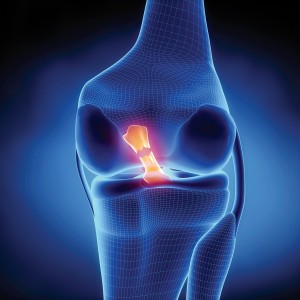Physio Health Advice > ACL Tears
What is an “ACL tear” and how does it occur?
The ACL, or anterior cruciate ligament, is a strong piece of connective tissue which attaches the thigh bone (femur) to your leg bone (tibia). The ACL is referred to as a “crucial” ligament due to the stability it provides to the knee joint. The job of the ACL is to prevent the tibia from sliding forward relative to the femur.
This ligament is injured in athletes more often than other populations, however injury to the ligament may occur in other ways. Injuries tend to occur when landing awkwardly from a jump, twisting the knee, or suddenly stopping from running. The ACL may also be injured during knee hyper-extension, or when hit from the outside. Many times, other tissues surrounding the knee are also damaged, including the medial collateral ligament, meniscus, joint cartilage, and bone marrow.
A musculoskeletal practitioner can formally grade the severity of ACL injuries. A grade I injury occurs when there is minimal damage to the ligament and the joint remains stable on testing. Grade II injuries occur when the ligament is partially torn. The joint becomes loose on testing, but still provides a degree of stability.
Grade III constitutes a full tear or rupture of the ligament. There will be no stability provided to the joint on testing.
What are the signs and symptoms of an ACL tear?
Many people will report hearing a “pop” in the knee associated with pain at the time of injury. Within a few minutes to hours of injury, there is likely to be significant joint swelling. Decreased range of movement of the knee is common, and the injured knee is typically unable to take full weight upon standing or walking. It may also feel unstable at times, such as a “giving way” sensation. Poor balance and coordination may also be experienced.
How can Physio help?
Non-surgical management of the injured ACL is taken when there is a grade I to grade II injury. Surgical management typically occurs for grade III injuries, and occasionally grade II injuries to the ACL. Your doctor or physiotherapist can help you decide whether non-surgical or surgical management is best for you.
Regardless of surgical or non-surgical management, your physiotherapist will assist you with improving your knee’s range of movement, lower limb strength, balance, stability and coordination. You will re-learn the tasks of walking, using stairs, and negotiating obstacles.
Early in rehabilitation, the RICE protocol (rest, ice, compress, elevation) is used in conjunction with static resistance type exercises to improve muscle contraction in the leg and increase blood flow in the area.
Throughout your rehabilitation program, you will progress through a variety of strength and mobility exercises targeted towards your individual needs, with goals of returning to your favourite sport or hobby as soon and as safely as possible.


